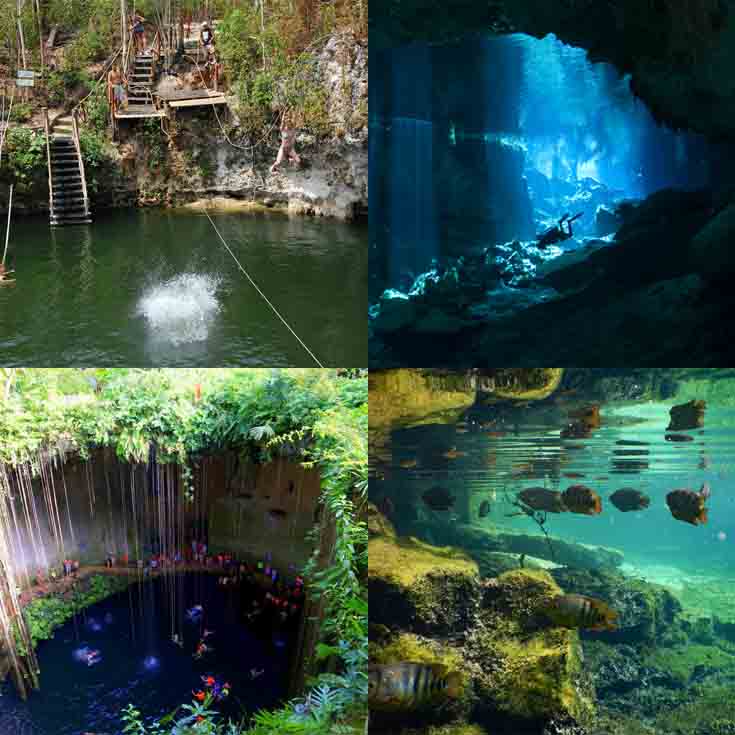
The local guide should follow permanent cavern lines, and all divers should be close enough to touch the line at all times. In some of the caverns that have lots of rock formation this visible light may not always be directly overhead, but you should still be able to see it.ĭivers who go into caverns will be in a small group, with a dedicated guide. Cavern Diving in MexicoĬavern diving is diving that takes place in overhead environments but always staying within the zone of visible light – meaning that as a cavern diver, you always remain close enough to the entrance that you can see sunlight. Cavern Diving: What’s the Difference?įor open water divers who are interested in diving in the cavern of a cenote, it is important to understand the important differences between cavern and cave. Regardless of your dive skill level, there are cenotes you can visit and dive in! Photo from CanvaĬAVE DIVING IN MEXICO Mexico Cave Diving Vs.

CHAC MOOL CENOTE DIVING FULL
Other caverns are very spacious with easy access, making them easier for divers.ĭivers who have completed the full cave diver certification are able to explore further into the overhead environment areas of the cenotes, or the caves. In some of the cavern dives, divers pass near delicate rock formations, and many different dive guides will want to see your buoyancy control and skill level before taking you into certain caverns. The caverns in this area are generally either shallow dives with a partial overhead environment or deep pits where divers go to a maximum depth of around 30 meters.įully cave-certified local guides can take certified open water divers on tours of the caverns, and the certified divers require no additional gear or training – just a very detailed briefing. In addition to these large, open cenotes, divers who are open water certified can dive in the cenote caverns. These types of cenotes are ideal for popular places for new divers, students taking a dive course, or snorkelers because the water is crystal clear, there is no current, and the depth is shallow. Often these cenotes are in the beautiful jungle or mangrove settings, with vegetation growing all around the water. There are several cenotes that take the form of large, freshwater pools. Nice halocline guaranteed.CAVE DIVING IN MEXICO Mexico Cave Diving: Who Can Dive in a CenoteĪfter learning what a cenote is, experienced divers find the urge to dive in one irresistible, and the great news is, that anyone can dive in cenotes.Īll the cenotes in the Yucatan Peninsula are different, ranging from large, open, and shallow water pools, to deep pits, to areas with partial overhang environments, to caves with total overhead environments.ĭepending on your certification, skill level, and desires, there are cenotes that are appropriate for you to dive in. The maximum depth of 47 feet-14 meters - takes you through salt water. The ceiling of this “air dome” is an open book on the past few hundreds of thousands of years with the beautiful fossils you will find, as well as some little “baby stalactites” and giant tree roots cracking the thin upper limestone to get some water. In the same room, you will also surface into a big air pocket with air access. Then, in the other section you will see a “dome room” made of thin stalactites which are on one side a huge collapse, and this section gives us a view of approximately 30 feet / 10 meters of a decorated low (bottom) wall section.

The cavern is very amazing for the variety of scenes that will present themselves during the dive, like the two enormous caverns where you enjoy sun light and beautiful jungle view from underwater.

The same site offers two Cenotes: “Kukulkan” see (cavern-kukulkan) and Chac Mool.Ĭhac Mool has two entrances, the main one, which is a big opening in the downstream section of the site, and also a small entrance called “little brother” which is actually a side entrance. A very famous place, 20 min away from Playa del Carmen right after the Puerto Aventura’s bridge.


 0 kommentar(er)
0 kommentar(er)
